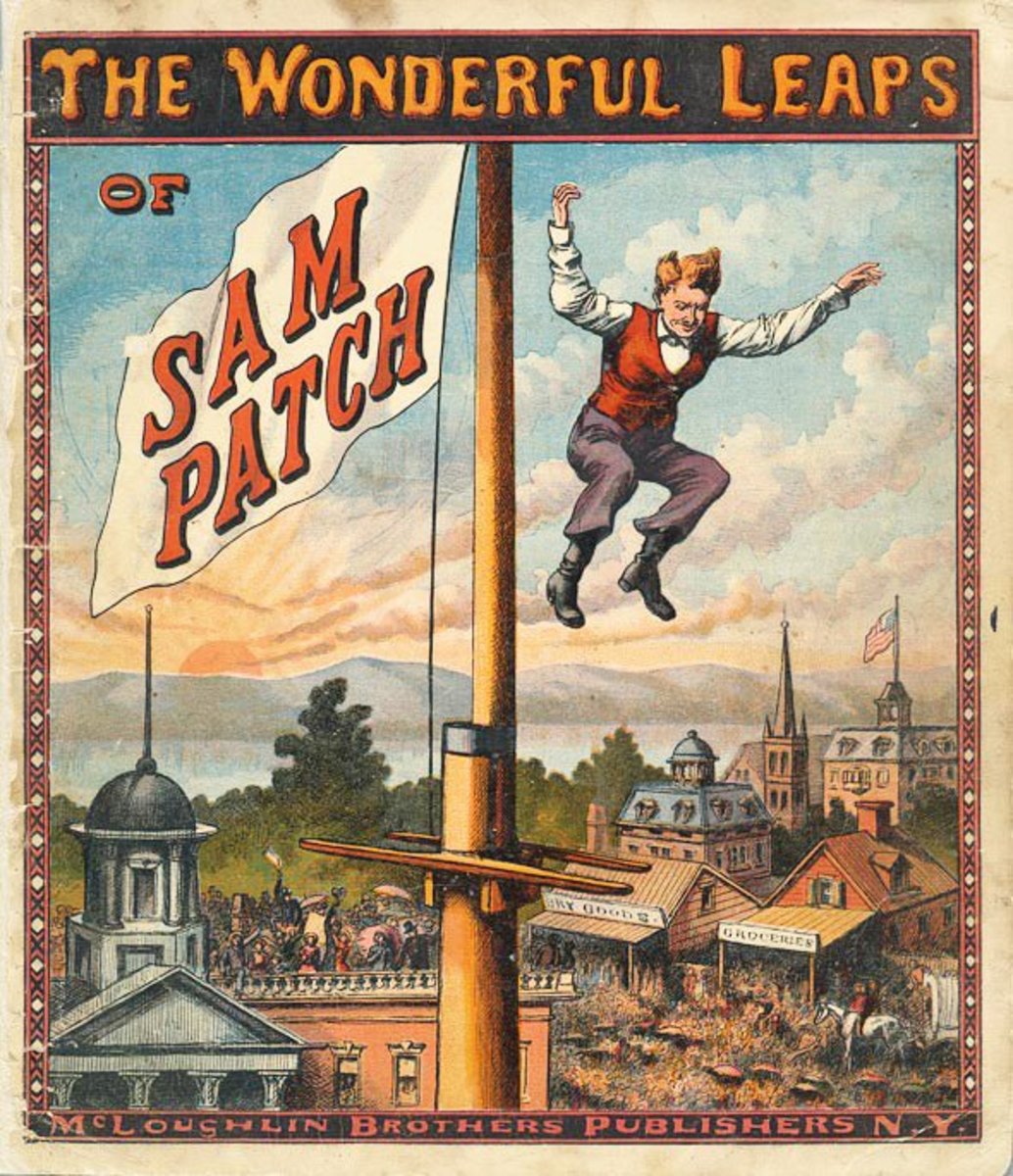 |
| Copy of a handbill from a play about the famous Sam Patch. |
The first person ever to
go over Niagara Falls and live to tell about it was a man named Sam Patch, who
accomplished the feat in October 1829. He earned the nickname the Yankee
Leaper as a result. His jump was part of a campaign to turn the Falls
into a more popular tourist attraction. It worked, too: a crowd of about
10,000 gathered to watch the 22-year-old Patch do it. Patch promised a second
jump because his first one was delayed due to technical problems—the ladder he
was to climb out to the middle of the falls on broke and had to be repaired—and
bad weather pushed his jump back to 4:00 in the afternoon. His second
jump saw conditions that allowed the jump and was much better attended, turning
Patch into a household name.
| Handbill from Sam Patch's final jump, 1829. This jump was not done as well as others. |
Patch had already
achieved a certain amount of fame for jumping off of waterfalls. Two
years earlier, in 1827, he’d jumped off of the Passaic Falls in New Jersey.
This turned him into a celebrity, making him very much in demand for
public appearances. He made a career out of jumping from waterfalls,
bridges and even ships’ masts. Patch was quite the draw, so when tourism
promoters in Niagara Falls reached out to him, they clearly knew what they were
doing. Patch the New Jersey Jumper transformed into the Yankee Leaper,
and he was going to cash in for all he could. Patch’s personal motto
“Some things can be done as well as others” entered popular currency, even
though it wasn’t exactly clear what this expression meant. It was printed
on handbills promoting Patch’s jumps, leaving the reader free to interpret it
as he or she wished.
The Passaic Falls were a
70-foot drop, which is much more manageable when compared to the daunting
167-foot drop at Niagara Falls, which Patch survived twice. Patch seemed
to be unstoppable—at any rate, it appears that he felt like he was. On
Friday, November 6, 1829, Patch went to the 99-foot Genesee Falls in upstate
New York and put on another well-attended spectacle. From the top of the
falls, he picked up his pet bear cub and threw it down the water. Once
the cub swam to the shore at the bottom of the falls, Patch jumped, and the
crowd went wild.
Though he drew some
paying customers, the haul from this jump wasn’t so great. Patch felt
this jump could raise more cash, so he announced he would jump again the
following Friday. To make it even more impressive, he had a wooden
platform constructed at the top of the falls, raising the height of his jump to
125 feet. Accounts differ as to whether Patch actually jumped or whether
he fell off, but witnesses (there were many) agree that Patch did not descend
feet-first like he usually did. From the surface of the water, spectators
heard a loud smack, but it was unclear what happened to Patch. He could
not be found.
This is the stuff that
legends are made of, so almost immediately rumors were flying that Patch had
slipped away to hide in a cave, savoring the excitement that his jump had
caused. The terrible truth was learned the following spring when a farmer
near Rochester found Patch’s frozen body in the Genesee River. Patch was
buried near Rochester. His small gravestone used to have a board placed
on top of it on which was written, “Sam Patch—Such is fame.”
Following his demise,
Patch’s celebrity continued. A series of plays about the Yankee Jumper
enjoyed well-attended performances well into the 1850s. President Jackson
even named his horse “Sam Patch” in honor of this daredevil.
Stunts in and around
Niagara Falls didn’t stop, either. Jumpers, swimmers, and tightrope
walkers challenged the falls, hoping to earn a little celebrity, themselves.
In 1901, on her 63rd birthday, a retired American schoolteacher named
Annie Edsen Taylor became the first person to successfully go over Niagara
Falls in a barrel. After she was fished out of the river, she announced,
“No one should ever do that again.” Since Taylor had no other means to
support herself in her retirement, she’d hoped to parlay her fame into a
lucrative income, but her public appearances never generated much interest, nor
did the never-seen film that reconstructed her jump. She attempted to
write a novel about the experience, which she never finished. Her
publicity manager ran off with most of her meager earnings from this tour.
Taylor died in poverty at age 83, having spent time working as a
clairvoyante, and attempting to cure people of their ailments using magnets, a
popular junk medical science of the day.
 |
| Annie Edsen Taylor and her famous barrel, 1901. Atop the barrel: the cat who served as test subject before her jump. |
Stunts still go on at
Niagara Falls. Fifteen more people went over them in barrels after
Taylor; ten survived. There have been other jumpers, and even an attempt
to jump the Falls on a Jet Ski (which was fatal). In 2012, a man in his
forties became the fourth person to survive jumping over the falls unprotected.
He suffered lacerations, broken ribs and a collapsed lung. Though
there’s still an allure to going over Niagara Falls, it’s illegal, and you’ll
be arrested whether you wash up on the American side or the Canadian one.
Only if you survive. If you don’t, the authorities generally don’t
press charges.


Comments